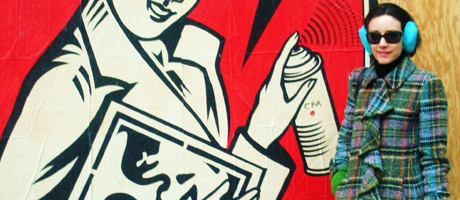By Menachem Wecker
One of the things Tracey Wheatley Perkins loves the most about her job is that there is no typical routine.
In the course of a day, Ms. Perkins, M.A. ’05, chief of staff at the Institute of Contemporary Art/Boston, can do anything from working with visiting artists to focusing on long-term projects to ensure the ICA can maintain its “quality exhibitions, attendance and impact.”
“What a lot of people don’t know about the ICA,” she says, “is how focused we are on creating future leaders in the arts through our teen programs.”
Not only has the ICA been focusing on cultivating future leaders recently, but it has also undergone a significant makeover. In December 2006, the ICA opened its new building, designed by the architecture firm Diller Scofidio + Renfro and rumored to cost $51 million, on the Boston waterfront.
According to Ms. Perkins, the new exhibition spaces and the reputation they have given the museum have been “dramatic and exciting.” Attendance has increased 10-fold since 2006, she says. “We are now a true international player, and we can attract amazing talent.”
Boston is a city known for its arts scene, but it is generally identified with the Museum of Fine Arts, Boston, Harvard University’s Fogg Museum and the Isabella Stewart Gardner Museum -- all built more than a century ago. Although contemporary museums like the Decordova Museum and Sculpture Park in Lincoln, Mass., and the Massachusetts Museum of Contemporary Art (MASS MoCA) in North Adams, Mass., have distinguished reputations, it is challenging for a museum like the ICA to carve out a niche in downtown Boston.
“I would say the art scene in Boston is unique in that contemporary art has to work much harder than in any other major U.S. city to get attention and support,” says Ms. Perkins. “There are some great artists here, but we lose a lot of artists to cities like New York and Los Angeles because of their more receptive environment and larger community.”
Museums in Boston and across the country have recently struggled financially, Ms. Perkins says. “The last year and a half have been very difficult for all nonprofits,” she says. “Fortunately, we have really smart staff and board leadership and have been able to keep ahead of a situation that has felled other nonprofits.”
When Ms. Perkins came to the ICA a year after earning a master’s in art history at GW, where she focused on art created between World War I and the 1970s, she started off as an executive assistant. It took a lot of “hard work and luck” to move up to the chief of staff position.
“It’s tough to avoid starting at the bottom of a nonprofit organization unless you are a highly sought-after specialist,” she says. “It’s a competitive field. I spent nearly a year and a half proving myself and then was in the right place at the right time when the chief of staff opportunity presented itself. I feel very fortunate!”
Before coming to GW, Ms. Perkins earned a bachelor’s degree in art history from Colby College in Maine. She had moved to Washington, “which has great culture and history,” and was struck by GW’s “amazing reputation.”
“I didn’t actually have any idea what I wanted to do after I graduated when I entered the program, but I knew I wanted to work with the arts,” she says. “I’ve always been interested in creating art but wasn’t any good at it, so studying art history allowed me to have that connection.”
Ms. Perkins is currently enrolled in an M.B.A. program at Boston University focusing on public and nonprofit management. Although she says it’s traditionally been unusual for people in the museum field to pursue business degrees, she thinks it is “trending in that direction.”
“A lot of nonprofits these days are looking for a more quantifiable and metrics-based approach to how they run their organizations and measure their impact,” she says.
At ICA, Ms. Perkins finds she often draws on her studies in Foggy Bottom. “Studying at GW taught me to clarify my thinking and how to best to articulate my thoughts,” she says.
She calls Melvin Lader, her thesis adviser who passed away right after she graduated, “the most influential professor I had at GW,” and she stays in touch with fellow graduate Allison Tillinger Schmid, M.A. ’06, assistant to the director of the Akron Art Museum in Ohio. “It’s interesting to compare stories and perspectives on what it’s like to work in a museum,” she says.
Ms. Perkins advises current GW students interested in working at a museum to establish connections with others in the field. “Keep an open mind, volunteer and get to know people who work in the art world,” she says. “Having someone put in a good word for you can do a lot."


